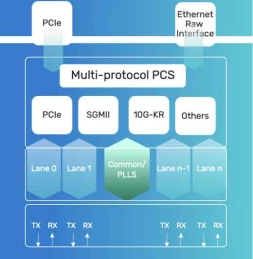Interface IP Cores for Samsung
Welcome to the ultimate
Interface IP Cores
for
Samsung
hub! Explore our vast directory of
Interface IP Cores
for
Samsung
All offers in
Interface IP Cores
for
Samsung
Filter
Compare
140
Interface IP Cores
for
Samsung
from
9
vendors
(1
-
10)
-
MIPI D-PHY Transmitter/Receiver for DSI/CSI-2 on Samsung 28nm FD-SOI
- Technology is Samsung 28nm FD-SOI 8M (6U1x_2T8x_LB).
- Supply voltage can be applied 1.1V for core voltage, 1.8V for IO voltage.
- Maximum data rate of each channel is 1.5Gbps at High-speed mode.
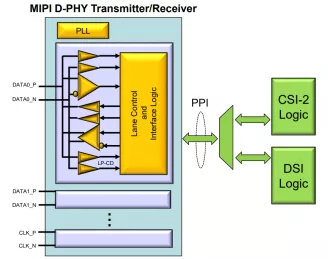
-
DP and eDP TX/RX PHY IP
- eDP v1.5 compliant
- Supports for 1.62Gbps to Max 8.1Gbps data rate
- PSR, PSR2 supported for low power consumption ( FW_SLEEP, FW_STANDBY supported )
- Supports for eDP v1.5 feature such as AUX-less Link Training
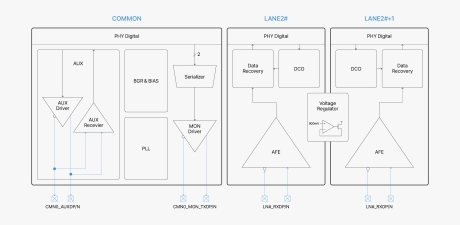
-
MIPI C/D-PHY Combo IP
- Compliant to MIPI D-PHY v3.0, C-PHY v2.1 specification
- Area efficient macro optimized for placement for dense SoC designs
- Support Uni-(TX or RX) and Bi-directional(TX and RX) mode
- Support emphasis architecture over lossy channel for TX
- Support equalize architecture over lossy channel for RX
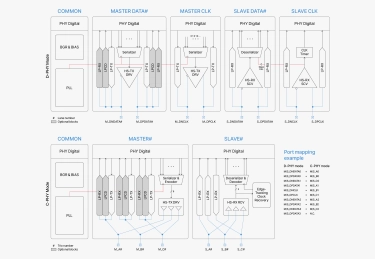
-
20G MSS (Multi-standard SerDes) PHY
- Developing under SF4X CMOS technology (2025.06.30 MTO)
- Compliant to multiple standards, max datarate 20Gb/s
- Channel Configuration for Data Lanes: 1, 2 or 4 Data Lanes
- Reliable Ring OSC PLL based architecture for Low power consumption
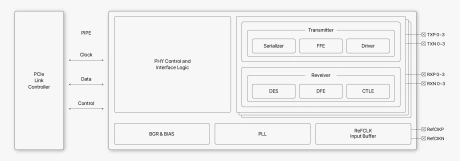
-
PCIe Gen4.0 PHY IP
- Best-in-class Power / Performance / Area competitiveness
- Compliant to PCIe 4.0 Base specification
- Supports lane configurations according to the user’s demands
- Supports data rates of 2.5GT/s, 5.0GT/s, 8.0GT/s and 16GT/s
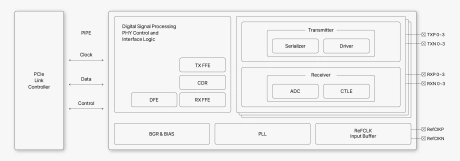
-
PCIe Gen5/6 PHY IP
- Best-in-class Power / Performance / Area competitiveness
- Compliant to PCIe 5.0/6.x Base specification
- Supports lane configurations according to the customer’s demands
- Supports data rates of 2.5GT/s, 5.0GT/s, 8.0GT/s, 16GT/s, 32GT/s and 64GT/s (PAM4)
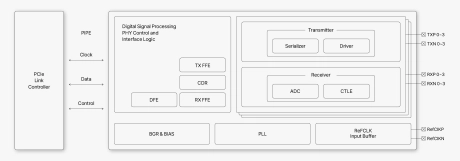
-
100G SerDes PAM4 PHY
- The SERDES PHY IP delivers a high-performance, low-power solution for high-speed interfaces up to 112Gbps.
- It supports diverse applications including AI accelerators, data centers, 5G infrastructure, and automotive SoCs.

-
USB4 PHY - SS SF4X, North/South Poly Orientation
- Supports 40 Gbps, 20 Gbps, 10 Gbps, and 5 Gbps data rates
- Supports 480 Mbps, 12 Mbps, and 1.5 Mbps data rates
- x1 and x2 configurations (USB 3.2 and USB 3.1 PHY only)
- Low active and standby power
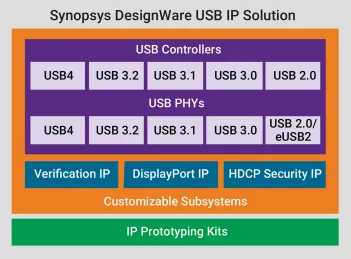
-
PHY for PCIe 6.0 and CXL
- Architecture optimized for HPC, AI/ML, storage, and networking
- Ultra-long reach, low latency, and low power
- Advanced DSP delivers unmatched performance and reliability
- Comprehensive real-time diagnostic, monitor, and test features
- Bifurcation support for x1, x2, x4, x8, and x16 lanes

-
PHY for PCIe 4.0 - Low-power, long-reach, multi-protocol PHY for PCIe 4.0
- Wide range of protocols that support networking, high-performance computing (HPC), and applications
- Low-latency, long-reach, and low-power modes
- Multi-Link PHY—mix protocols within the same macro
- EyeSurf —non-destructive on-chip oscilloscope
- User-friendly graphical interface provides easy access to embedded bit-error-rate (BER) and pattern testers and monitors to measure the link performance in real time
